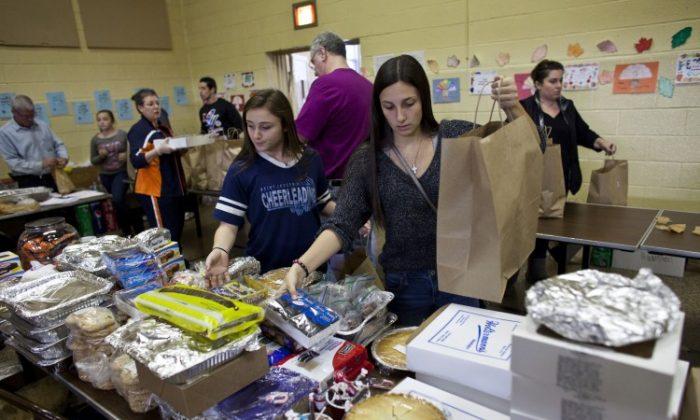Chaotic and Surreal Scenes
New Yorkers in Zone A areas were ordered to evacuate more than 24 hours before Sandy struck, but many didn’t.
A portion of the 60th District is considered Zone A, or especially prone to flooding.
Some of the residents in the area left their homes with nothing but the clothes on their backs. The Fire Department of New York rescued more than 150 people in the Midland Beach area within the district. Some parts were flooded higher than 6 feet.
The night of the storm was chaotic, said Malliotakis. People who hadn’t evacuated couldn’t get a response from the overtaxed 911 system. Social media proved a crucial way of relaying information.
In the days after, Malliotakis and volunteers in the heavily damaged region began going door to door with pasta and water. They looked for survivors. They helped people who were in homes that had become dangerous find a place to stay. They dragged ruined possessions out to the curb. Volunteers, community groups, and officials focused during the first week and a half on basic needs—such as getting people food, clothing, and blankets.
Aileen Gemma Smith, who lives in Dongan Hills just above Midland Beach, five blocks from the beach, said it was as though the area “had become a huge pond.”
“The scene is scary because it’s hard to fathom that it’s so much water,” she said, recalling coming back to the area a day after the hurricane. “You can look at photos and say ‘Wow, all the yards are full,’ but standing there, seeing, it’s like someone just waved a wand, and now they filled in every single low area, and it’s completely, completely full.”
‘Still in need of the basics’
Now, just over four weeks after Sandy, the region is still nowhere near normal. Multiple groups of volunteers still gather, mostly on weekends, helping clean up. Matching Staten Islanders with supplies is still a big part of daily life. Winter is here. Malliotakis is working with different companies, such as Adidas, to provide residents with shoes. Other entities are providing things like boots and baby food. A warehouse for goods has been set up across from her office.
“There’s a lot to deal with,” said Malliotakis. Many of her constituents “are still in need of the basics.”
The storm’s ruthless water-charged punch dramatically shifted the thinking about living near the water. Malliotakis wants the government to buy the land of people who want to move at the land’s pre-storm value.
“I’ve met many constituents who really do not want to go back,” she said firmly. “They would like an option to sell their land.”
She says this bold endeavor could only work with involvement from all levels of government. She has had multiple meetings with other officials about the proposal and will have more. The bought land would ideally become a part of the blue belt or wetland systems.
She also supports building sea walls or berms and potentially changing the building code so homes couldn’t be built so close to the water.
Smith said that already at least one family in the neighborhood, who has a son in her son Ryan’s eighth-grade class at I.S. 2 George L. Egbert, is moving away, to Florida.
“They’re devastated about it, but the amount of dollar damage to their home is such that they can’t afford to rebuild even if they get the maximum $31,900 from FEMA plus flood insurance,” she said. “They just want to walk away from it and find another way to start over.”
Smith, 40, married with two teenage sons, said she is not sure whether she will stay in the neighborhood. It’s nice because her family is within walking distance of her parents. But if the family’s lot is part of a flood zone in the yet-to-be-redrawn flood maps, they will likely move to another area of the island.
‘Pockets of Normalcy’; nearby, houses still being gutted
Many Staten Islanders in the area are still struggling, said Smith.
About 1,900 small businesses were affected on the island as a whole, she said. Smith owns a startup that analyzes data, so she performed her own analysis. The bagel shop down the street, for instance, is still shuttered.
Meanwhile, the difference between adjacent areas gives an eerie feeling to the current situation.
“There’s pockets of normalcy,” said Smith, “Then, three blocks away, you still see folks gutting houses and people saying ‘I don’t know when we can come back home, I don’t know what we’re going to do next.’”
The Smith’s home is on a relatively high piece of land and so their basement was flooded but not severely. On the same street, however, are homes “tagged” with the red paper that lets homeowners know their homes will be demolished due to substantial damage. Smith said more than 200 homes have been condemned across the island.
A nearby family’s plight, the Gatti’s, has especially impacted Smith. They had three generations living in their house, which was moved off its foundation by the storm. Now Anthony, of the youngest generation, is camping outside the red-tagged house in a tent because they are afraid of looting.
But a common sentiment that Smith has seen has heartened her. Many of the families who lost possessions and experienced flooding draw optimism from still having their families.
“There are folks who are saying ‘Yeah, I got $20,000 worth of damage, but my family is okay, and I can actually rebuild some of these things, and so what if we lost clutter in the basement,’” she said. “You tend to see more of that than folks being outraged, because they know that people who are within walking distance have had things much, much worse.”
The Epoch Times publishes in 35 countries and in 19 languages. Subscribe to our e-newsletter.
Please send news tips to [email protected]
















Friends Read Free